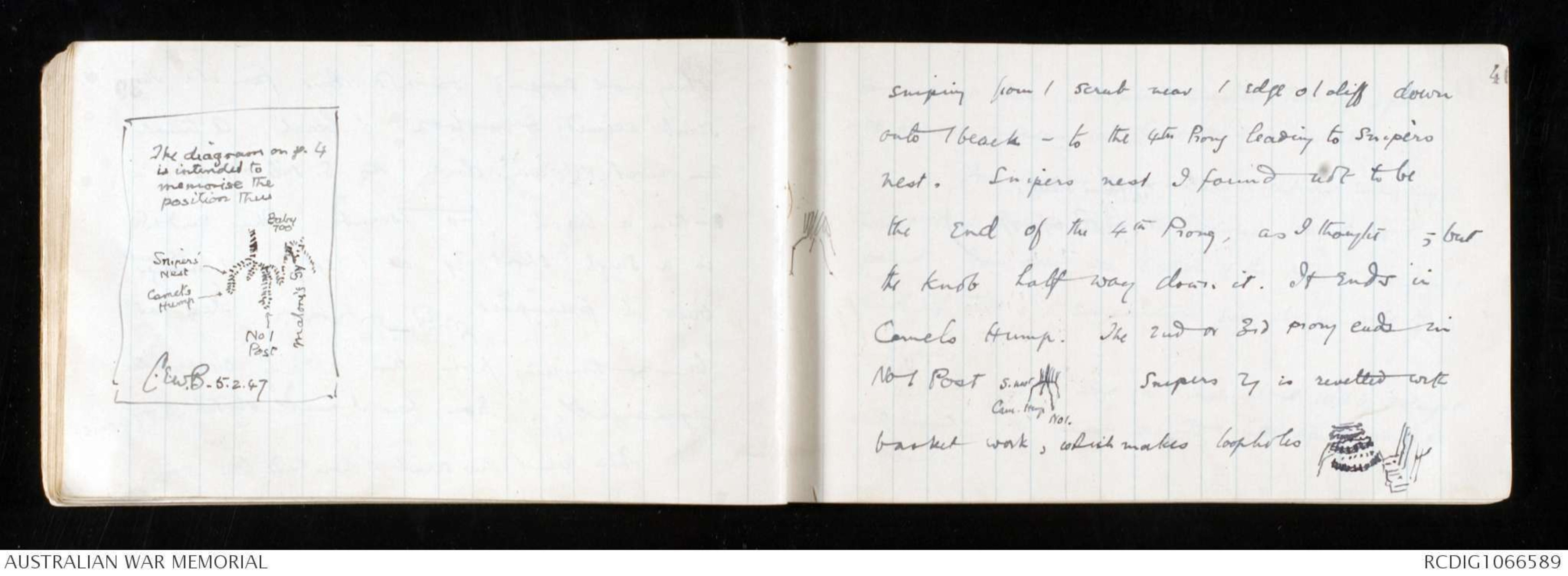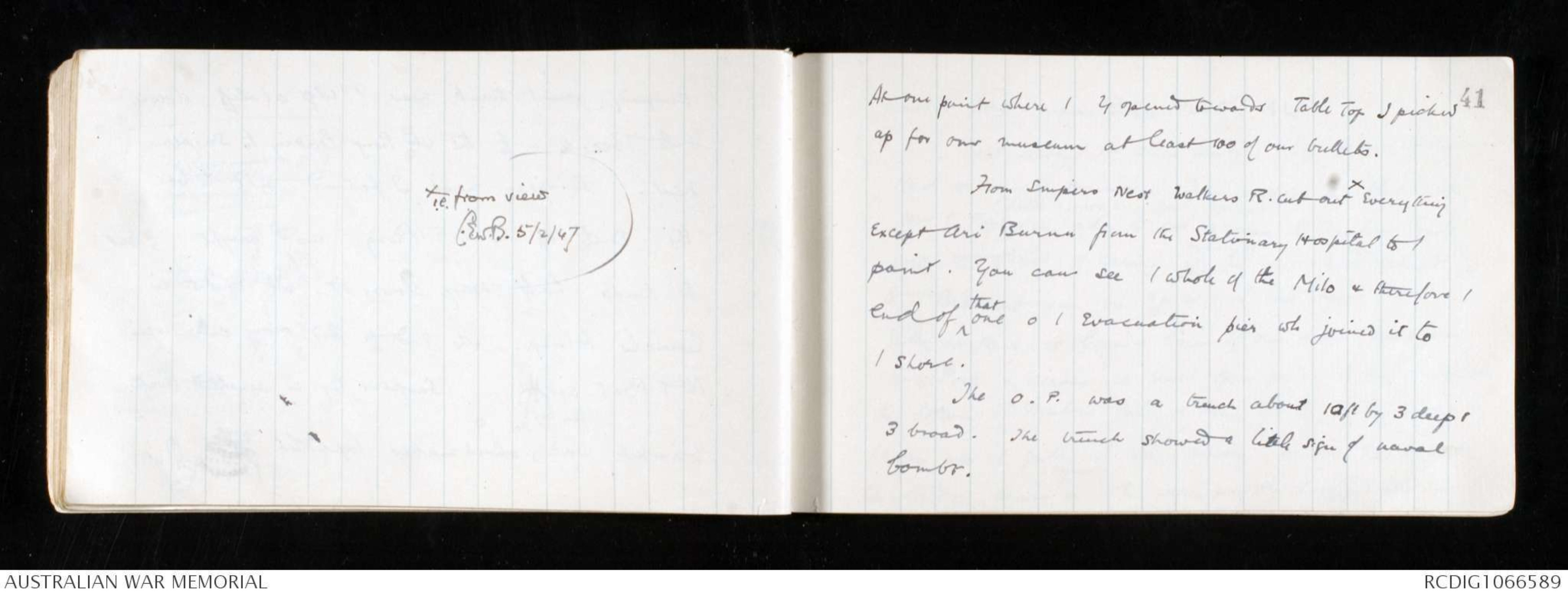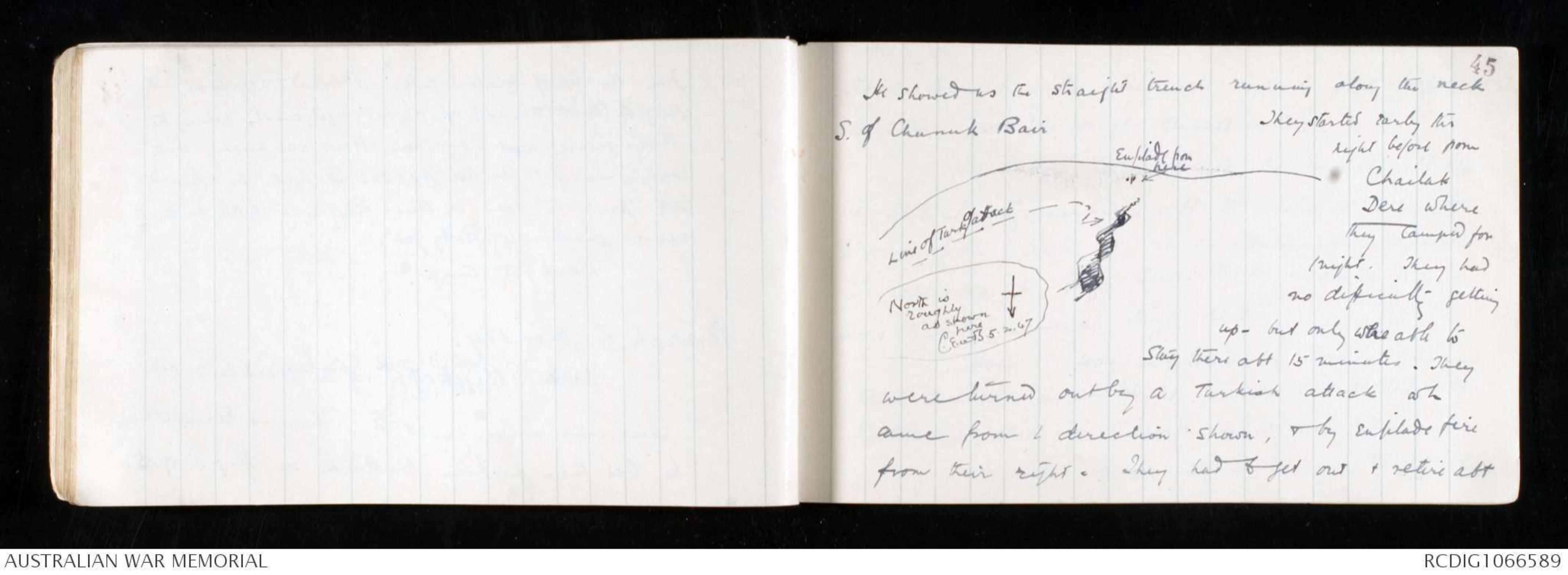Charles E W Bean, Diaries, AWM38 3DRL 606/230/1 - February - March 1919 - Part 5










X The field notes of the track work are in Book 231
p. 104, (since transcribed) C.E.W.B. 21/1/47
24-29. These positions were ^evidently transferred from my field
Map A to Lt. Buchanan's tracing ^T4 (with the
A.H. Mission tracings) It T4 is probably the
best authority for them. C.E.W.B. 21/1/47
X 27 appear to be in the same
place as 17 in my map.
(The pencilled lettering can
be seen under the ink.)
C.E.W.B. 21/1/47.
37
in / low scrub - This line ended near
graves of 4 or 5 men (28)X up near / W side o /
6 in gun enclosure. The G graves were a little
in rear o / line - certainly buried in Armistice.
There were I suppose 12 bodies visible on
this line. In / forward line just S. o /
big gun there were abt 20 or 30 I shd say - there had
bn firing from this line also. Nothing like as many of
our cartridges ^or clips remain as in / case o / Turks- but perh.
they have bn picked up. ( Front line 27.)X
The position of 29 is given in Buchanan's
tracing. C.E.W.B 21/1/47. (It is abt 80 n 6)
————
[X xxxxxxx On my field map (1/20,000 Koju
Dere) the figure 29 xxx may be where I have marked
in ink ./. & queried it. A pencil mark
which may be 9 is visible. This certainly
is not the position of the 6" gun.]
C.E.W.B. 21/1/47
Later. more probably that is 27,xxxxxx The word
Farelhest xxxxxxxx
apparently indicates the position
which I originally asked Buchanan
to mark as 30. Afterwards 30 was
used for another position, at Pine Ridge.
38
on the NW. side of the 6 in. gun I found again / bodies
of our men - 20 or 30 of them; perhaps more. With the
leading one ws a New Zealander - for part of a N.Z.
entrenching tool cover ws w him. These men as
far as I cd make out were trying to get over /
top of Baby 700 facing B'Ship Hill. (29 here).X
From there I struck down to wooded slope
from which sniper's rest springs. There were
4 prongs to this ridge - Snipers Rest is most
N.Ely. I often looked at this ridge & wondered
39
why more sniping ws not done from it. The
scrub seemed to overlook / beach. A trench
ran most o / way down the S. side o / ridge -& - then a track thro / scrub. This ended
in a single short trench at / edge o / ridge scrub
over / precipise
Diagram - see original document
There had
bn no sniping from this - only observatn
apparently. From here I made sketch AT (4 parts)
Then went thro scrub - there had bn some
The diagram on p. 4
is intended to
memorise the
position there
Diagram-see original document
C.E.W.B. 5.2.47
40
snIping from / scrub near / edge o / cliff down
onto / beach - to the 4th Prong leading to Snipers
Nest. Snipers nest I found not to be
the end of the 4th Prong, as I thought; but
the knob half way down it. It ends in
Camels Hump. The 2nd or 3rd prong ends in
No 1 Post
Diagram - see original document
Snipers trench is revetted with
barked work, which makes loopholes
Diagram - see original document
X i.e. from view
C.E.W.B. 5/2/47
41
At one point where / trench opened towards Table Top I picked
up for our museum at least 100 of our bullets.
From Snipers Nest Walkers R. cut out X everything
except Ari Burnu from the Stationary Hospital to /
point. You can see /whole of the Milo & therefore /
end of ^that one o / evacuation pier wh joined it to
/ shore.
The O.P. was a trench about 10ft by 3 deep &
3 broad. The trench showed a little sign of naval
bombs.
42
Sketch from Snipers Ridge Nest. AU.
Went along the steep knife edge from Snipers
Nest to Camels Hump. Then across the flat & up
No 1 Post ^(Sketch AU from here showing 4 prongs) in order to get across to Malone Gully
with the object of seeing if ^many of the men had retired
to / Beach tt way on Ap. 25. I had heard tt /
Gully ws thick w bones & traces of our men. Went over
No 1 Post & across a level open patch to the stream in
the bottom of Malone Gully & then up / gully. All
/ way up / gully I was coming across Turk bull
cartridge cases - wh were probly dropped there on
43
Ap 25. Higher up they were certainly the shells of snipers
positns - fired at No 1 Post. The bullets fired back by No 1
post were there also.
I was almost exhausted before getting to / top of No 1
Post; & going up Malone's Gully, wh ws very steep - at
one time I wondered if I shd be able to get to / top.
carrying the trophies I had picked up (not as heavy
probably as our men's kit on / first day).
There ws not a shred of our kit until
very near / top when I struck a waterbottle or
something wh seemed to have fallen from Baby 700.
The Nek.
X Sk. A W from
here.
C.E.W.B.
9/2/47
X Lieut. C. V. Bigg-Wither
C.E.W.B. 5.2.47
44
From the top of Malone Gully X I looked across at the
Prong 4 (Southern most) of the 4 pronged crest, where the
Turks were agst at whom Howe was sniping with
some men of 12 Bn on Ap 25. The fighting he afterwds
took part in was on this Prong 4 a little further E
nearer junction w Baby 700.
Back to Camp.
March 3. Monday.With Biggwether X of the Auckland M.R.
came over & we went to Chunuk Bair where
he had taken part in / attack on Aug 8. 1915.
45
He showed us the straight trench running along the neck
S. of Chunuk Bair
Diagram - see original document
They started early the
night before from
Chailak
Dere where
they camped for
/ night. They had
no difficulty getting
up - but only were able to
stay there abt 15 minutes. They
were turned out by a Turkish attack wh
came from / direction shown, & by enfilade fire
from their right. They had to get out & retire abt
46
50yds down / hill. They were right in front of Sazli
Beit Dere, Wellington on rt, Auckld on left.
The shallow trench in wh the English reld them
is still clearly marked - abt the centre it is exactly
50 yds from / centre o / rd on / summit. Its positn
in reference to Sazli Beit is shown in sketch A X.
Some reinfts came up Sazli Beit.
How it was enfiladed by / Turks on Chunuk
Bair is shown in sketch AY; How it is enfiladed by
Battleship Hil is shown in sketch A Z.
Malones H.Q. ws not in / trench I thought (Bigg
 Sam scott
Sam scottThis transcription item is now locked to you for editing. To release the lock either Save your changes or Cancel.
This lock will be automatically released after 60 minutes of inactivity.